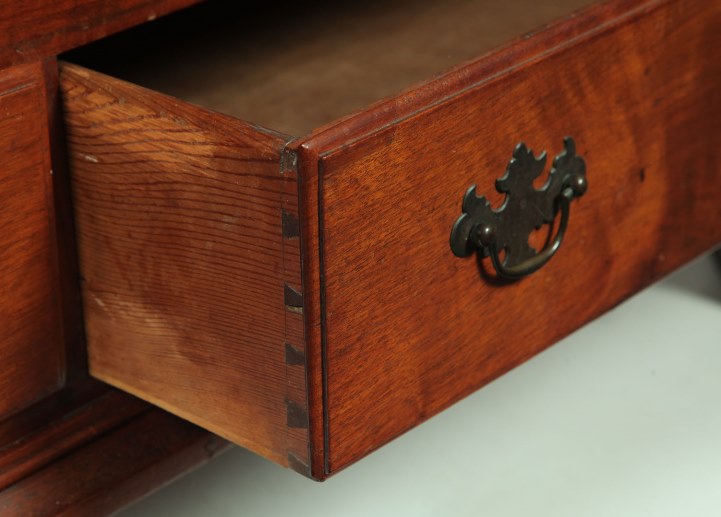 Examining a piece of furniture is like examining a crime scene – forensics play a role in unraveling puzzles about the who, what, where, when, how of each object. One of the “fingerprints” commonly found in pieces of furniture is the dovetail joint (also known just as dovetail or, in Europe, often called a swallowtail or fantail joint). The photograph here shows the front corner of a drawer in a chest. The chest itself is also dovetailed. While no one really knows how old the dovetail joint is, some of the earliest examples are from pieces found in ancient tombs, both in China and in Egypt.
Examining a piece of furniture is like examining a crime scene – forensics play a role in unraveling puzzles about the who, what, where, when, how of each object. One of the “fingerprints” commonly found in pieces of furniture is the dovetail joint (also known just as dovetail or, in Europe, often called a swallowtail or fantail joint). The photograph here shows the front corner of a drawer in a chest. The chest itself is also dovetailed. While no one really knows how old the dovetail joint is, some of the earliest examples are from pieces found in ancient tombs, both in China and in Egypt.
Dovetails are used in the construction of furniture as well as buildings as joining techniques in a way that offers impressive tensile strength. A dovetailed joint is like interlaced, interlocking fingers. (They’re technically referred to as “pins” and “tails.”) These fingers have a wedge or trapezoidal form and are glued together when finished, meaning an entire piece of furniture – or even an entire log cabin – can be assembled without so much as a single nail!
While most catalogers rarely make the distinction, dovetails can be accomplished in several ways – through, half-blind, secret mitered, sliding and full blind. In specific instances with a large enough body of work to compare, they can link objects to a particular cultural group, a specific shop or even identify the hand of a particular maker. (For instance, English dovetails are often perceived to be finer and more delicate, while Germanic ones tend to be seen as wider and more robust, but even this changes over time and in communities where both populations worked together or other factors influenced the practices of a local shop.)
In the early days of more industrial furniture production, dovetails were still handcut, banged out from templates in the kind of repetitive work that fell to apprentices and journeymen, but by the early 20th century, factories had figured out how to cut dovetail pin and tail wedges with machines. Around this same time, machine-cut joints, fashioned with rectangular pins and tails versus the traditional wedges, began to appear. While occasionally misidentified, these are technically not dovetails, as dovetails draw their very name from their wedge-like resemblance to a bird’s tail, but finger joints.



